Best Coconut Panna Cotta with Mango Puree to Try Now
Coconut Panna Cotta with Mango Puree is the kind of dessert that just feels like vacation in a spoon. It is creamy, silky, lightly sweet from coconut milk, and then you get that bright sunny layer of ripe mango on top. If you love tropical flavors and simple desserts that still look restaurant fancy, Coconut Panna Cotta with Mango Puree might become your new signature dessert.
Before we dive in, I want to tell you why this recipe matters to me, because it is not just a basic panna cotta. It is honestly a little piece of my story. On the About page of my site [Internal Link: About Just Thai Recipes], I talk about how this whole journey started in a small kitchen with a stack of coconut milk cans, fresh herbs from the local Asian market, and a lot of trial and error. I grew up around a style of cooking that never felt intimidating. There was no strict measuring, only taste, smell, and feeling.
Coconut milk simmering on the stove with pandan leaves. Sticky rice in banana leaf packets. Mango with coconut cream chilled and served at the end of a meal. These flavors always tasted like comfort to me, and like celebration. So when I started the site [Internal Link: Just Thai Desserts Collection], I knew I wanted to share desserts that are approachable, tropical, and quietly beautiful. Coconut Panna Cotta with Mango Puree fits that so well.
The first time I made Coconut Panna Cotta with Mango Puree at home, I was honestly trying to impress dinner guests without stressing. I wanted something I could make ahead. Something that looked like I spent hours in the kitchen, but secretly did not. Panna cotta is perfect for that. You cook the base gently, you chill it, and the fridge does most of the work for you. When you spoon the golden mango puree over the pale coconut base, it looks like something you would see in a restaurant or on a cooking show.
In this guide, I am going to walk you through Coconut Panna Cotta with Mango Puree in a way that is friendly, clear, and basically foolproof. You will learn how to bloom gelatin, how to infuse coconut milk with pandan leaves for aroma, how to choose mangoes that blend into a smooth and sweet puree, and how to layer and serve the final dessert so it actually looks as good as it tastes. If you are searching for easy coconut panna cotta with mango puree, or coconut panna cotta with mango puree no cream, or even coconut panna cotta with mango puree bbc good food style, you are absolutely in the right place.
I will also share small tricks that come from experience. Like, when to stop heating the cream so it stays silky and does not curdle. How to chill in clear glasses for the prettiest presentation. How long to let it set so it does not slump when you spoon on the mango. And I am going to answer common questions people search for, like mango coconut panna cotta recipe, mango panna cotta pudding recipe, and coconut panna cotta masterchef style plating.
If you are new here, welcome. I share Thai inspired recipes and dessert ideas meant for real home cooks, not just professionals. Coconut Panna Cotta with Mango Puree is one of those recipes I truly want you to feel confident making. It looks impressive, it tastes tropical and luxurious, and it is actually very doable even if you do not consider yourself a dessert person. By the time you finish reading this Coconut Panna Cotta with Mango Puree guide, you will be able to prepare it for date night, holidays, family dinners, or just for yourself on a quiet evening when you want something cold and comforting from the fridge.
Now, let us build it from the ground up, ingredient by ingredient, flavor by flavor.
Table of Contents
Table of Contents
Ingredients
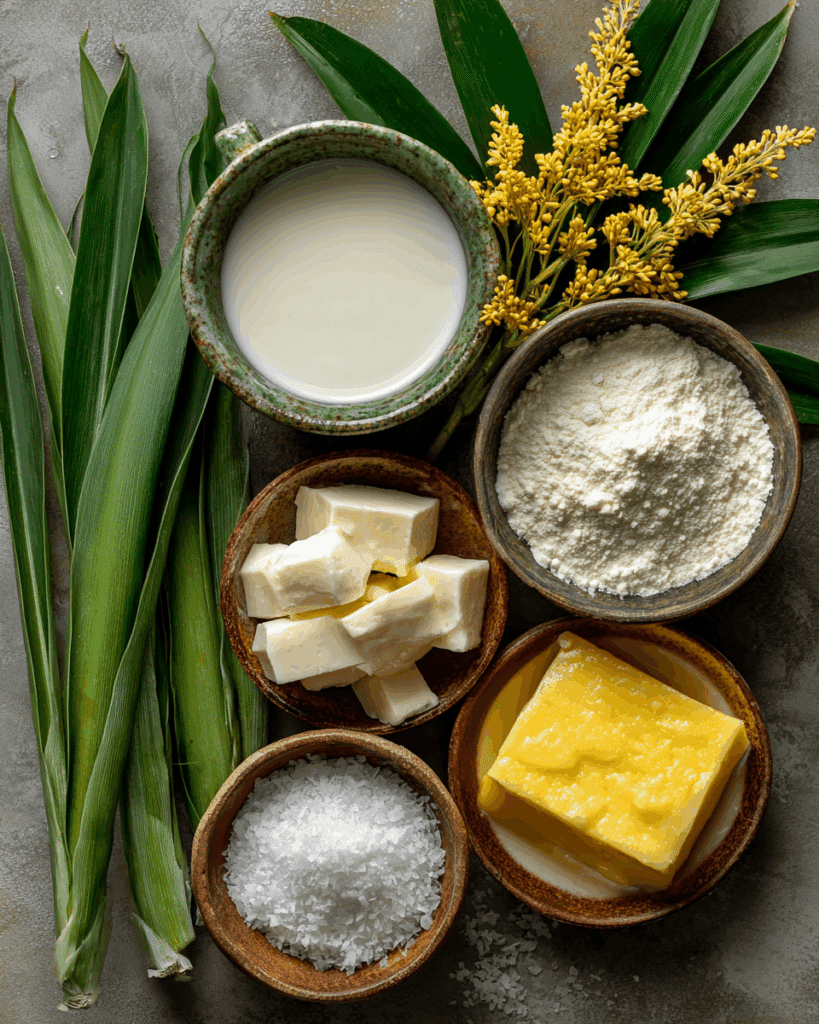
To make Coconut Panna Cotta with Mango Puree, you actually do not need a long grocery list. The magic here comes from the quality of the ingredients and how you treat them. I am going to walk you through each one, why it matters, and how to choose the best version so your Coconut Panna Cotta with Mango Puree sets properly and tastes rich but balanced.
For the coconut panna cotta base
1 cup coconut milk
1 cup heavy cream
2 teaspoons plain gelatin powder
1/3 cup sugar
2 pandan leaves, knotted
For the mango puree topping
2 ripe mangoes
Now let us break down what each ingredient does in Coconut Panna Cotta with Mango Puree, and how you can adjust it to match your taste or dietary needs.
Coconut milk
The coconut milk is the heart of the flavor. It is what makes Coconut Panna Cotta with Mango Puree taste tropical and luxurious instead of just tasting like a regular vanilla panna cotta. You want full fat coconut milk, not the light version, because fat equals creaminess. The fats in coconut milk help the panna cotta set into that signature silky spoonable texture instead of turning rubbery. If you are going for a coconut panna cotta with mango puree no cream style dessert, you can actually replace the heavy cream with more coconut milk or even canned coconut cream. The flavor will be more intensely coconut, and a little denser, but still amazing.
Heavy cream
Heavy cream gives the panna cotta body and smoothness. The combination of coconut milk plus heavy cream creates that classic panna cotta feel that melts slowly on your tongue. This is what restaurants lean on. If you have ever tasted a coconut panna cotta masterchef style, you know what I mean. If you want a lighter dessert, you can reduce the heavy cream a bit and use a touch more coconut milk. The texture will still work as long as you do not water it down too much.
Gelatin
Gelatin is what turns the liquid mixture into panna cotta. You only need two teaspoons here, which is enough to make Coconut Panna Cotta with Mango Puree set softly so it is tender and wobbly. You do not want a firm jello texture for this recipe. We bloom the gelatin first in the cold liquid so it can absorb before we heat. I will explain that more in the next section when we walk through the full method. If you add too much gelatin, the Coconut Panna Cotta with Mango Puree will set too hard. If you add too little gelatin, it will not hold the mango puree topping and it will slump. So measure this one.
Sugar
We use one third cup of sugar. That may seem modest, but keep in mind that you are also topping Coconut Panna Cotta with Mango Puree with super ripe mango, which adds natural sweetness. If your mangoes are very sweet, you can even reduce the sugar slightly in the base. On the other hand, if you like a more dessert forward sweetness, feel free to add a tablespoon or so more. Sugar also helps texture, not just flavor. It helps the panna cotta finish smooth instead of grainy.
Pandan leaves
Pandan leaves are optional, but when I tell you they make Coconut Panna Cotta with Mango Puree smell like a legit Thai dessert shop, I mean it. Pandan is sometimes called Asian vanilla. You gently knot the leaves and steep them in the coconut milk and cream as it warms, then remove them. The flavor is soft, floral, and slightly nutty. If you love traditional Thai and Southeast Asian sweets, pandan is worth finding. If you cannot find pandan, you can leave it out. Do not try to replace it with vanilla extract one to one. The aroma is different. Vanilla is deeper and dessert like. Pandan is fresher and greener.
Mango
Now we get to the topping that really makes Coconut Panna Cotta with Mango Puree special. You want two ripe, juicy mangoes. When you press them gently, they should have a little give. They should smell fruity near the stem, not sour and not fermented. You will blend most of the mango into a smooth puree that becomes the bright golden layer on top of the panna cotta. You can also save some of the mango and dice it into tiny cubes for garnish. That way the final Coconut Panna Cotta with Mango Puree gives you a balance of silky and juicy.
Why mango works so well with coconut
Coconut is rich, mellow, round. Mango is sweet and sunny but also a little tangy. When you layer the puree over the coconut base, every spoonful of Coconut Panna Cotta with Mango Puree gives contrast. That contrast is why so many people search for mango coconut panna cotta recipe or mango panna cotta pudding recipe. It is comforting and fresh at the same time. Similar combinations show up in Thai food culture again and again. Think coconut sticky rice served with mango, which is a classic Thai style dessert. Coconut Panna Cotta with Mango Puree is like a panna cotta version of that same pairing.
If you want to explore other takes on this pairing, you can look at recipes like coconut mango panna cotta from A Classic Twist like Coconut Mango Panna Cotta which shows how mango and coconut play together in a chilled dessert, or coconut panna cotta with mango puree from Rachel Cooks Thai like Coconut Panna Cotta with Mango Puree which leans into Thai style flavors and texture. These are great for inspiration, and you will notice that every version keeps that tropical duo. Coconut plus mango. Smooth plus bright. Familiar, but still special.
Step by Step Instructions
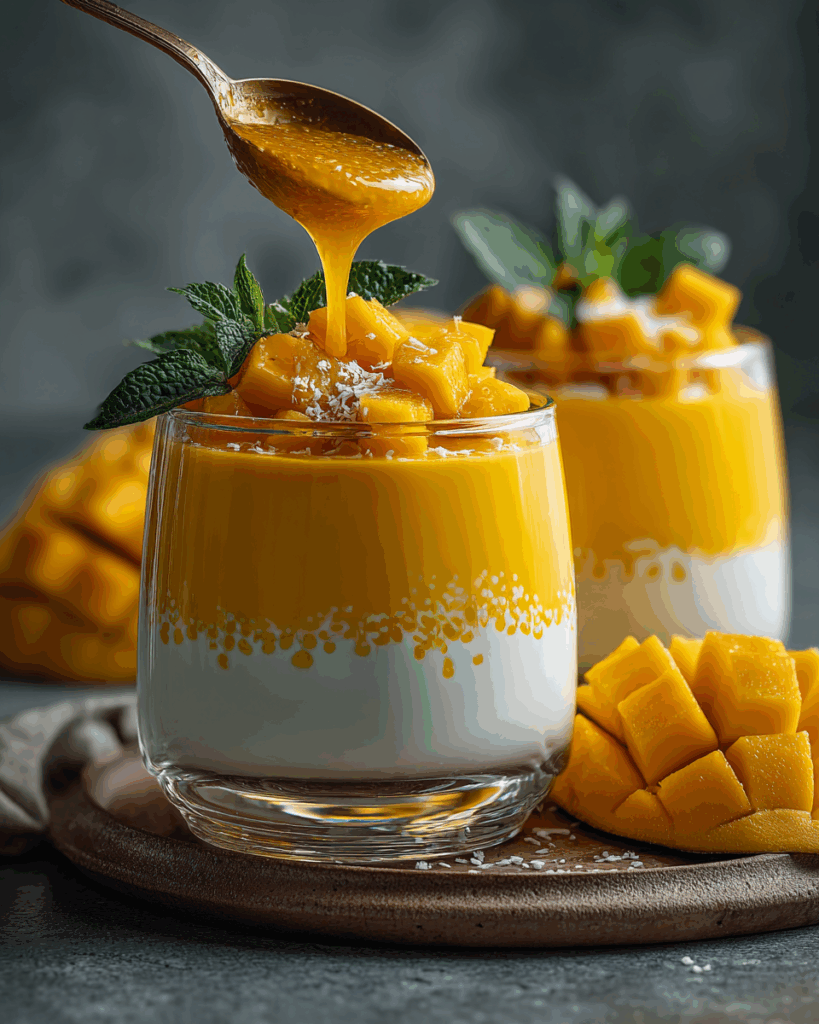
Now let us walk through the full process of making Coconut Panna Cotta with Mango Puree, one stage at a time. This is where everything comes together and starts to make sense in a very practical way.
Step 1. Bloom the gelatin
Take a small saucepan and pour in the coconut milk and the heavy cream. Do not turn on the heat yet. Sprinkle the gelatin evenly across the surface of the liquid and let it sit there for about five minutes. This step is called blooming. Blooming lets the gelatin absorb liquid and soften. If you skip this step and just dump gelatin into hot liquid, it will clump and you will end up with grainy bits in your Coconut Panna Cotta with Mango Puree. So let it sit quietly, no heat, about five minutes, until it looks thicker and a little wrinkly on top.
Step 2. Gently heat until smooth
After blooming, add the sugar and the pandan leaves to the saucepan. Now turn the heat to medium low. Stir slowly and constantly. You want the sugar to dissolve and the gelatin to melt completely into the coconut milk and cream. You do not want the mixture to boil hard at any point. Boiling can ruin the silky final texture of Coconut Panna Cotta with Mango Puree because high heat can make dairy separate and it can also weaken the setting power of gelatin. You are aiming for warm steam and maybe a few tiny bubbles around the edge. As soon as it is smooth and everything looks fully dissolved, turn off the heat.
Step 3. Strain and pour
Remove the pandan leaves and discard them. If you want the absolute smoothest Coconut Panna Cotta with Mango Puree, you can pour the hot mixture through a fine mesh strainer into a measuring cup with a pour spout. This helps catch any undissolved bits. Then pour the panna cotta base into your serving cups or ramekins. Try to fill each cup evenly so they chill at roughly the same rate. At this stage the mixture is still liquid, so handle carefully.
Step 4. Chill to set
Move the cups to the refrigerator. Let them chill for at least 30 minutes, and up to 2 hours, or until the panna cotta is softly set. You can test by giving a gentle nudge to the side of one cup. It should jiggle like a soft pillow, not splash like a liquid. This chilled base is the coconut layer of your Coconut Panna Cotta with Mango Puree.
Step 5. Blend the mango puree
While the panna cotta chills, peel your mangoes, remove the pits, and cut the flesh into big chunks. Add the mango to a blender and blend until silky. You should not need extra sugar if your mangoes are ripe, but you can taste and adjust. If you want the puree to be extra glossy and smooth for presentation, you can strain it, but that is optional. This puree is your topping layer for Coconut Panna Cotta with Mango Puree. Save a handful of small diced mango cubes on the side if you like a fresh garnish on top.
Step 6. Finish and serve
When the panna cotta is fully set, spoon the mango puree over each cup. You can go for a thin elegant layer, or a generous thick layer that takes up almost half the cup. Add fresh mango cubes on top for texture. At this point, Coconut Panna Cotta with Mango Puree is ready to serve. You can enjoy it right away, or keep it chilled until dessert time.
This method gives you a dessert that is cool and creamy, with a tropical balance of flavors. It is simple enough for a weekday dinner but pretty enough for a celebration. Coconut Panna Cotta with Mango Puree is also naturally impressive in clear glasses, which makes it great for parties, date nights, showers, or any time you want something that looks beautiful with very little effort.
Tips and Tricks
This is the part where Coconut Panna Cotta with Mango Puree goes from good to absolutely beautiful. These are the tiny choices and the small habits in the kitchen that make the final Coconut Panna Cotta with Mango Puree come out silky, set just right, and layered in a way that makes people think you got it from a restaurant.
Use full fat coconut milk
Full fat coconut milk matters for texture. Coconut Panna Cotta with Mango Puree should feel soft and creamy on the spoon, not watery or bouncy. If you use light coconut milk or a coconut drink from a carton, it will not set with the same luxurious body. You want that thick canned coconut milk that has a rich coconut cream layer at the top when you open it. Give the can a good shake or stir it so the fat is evenly mixed before you add it to the pan. This is the base flavor of Coconut Panna Cotta with Mango Puree, so it should taste like real coconut and not like something diluted.
Do not rush the gelatin
Blooming gelatin sounds technical, but really it just means you let the gelatin sit in the cold coconut milk and cream before you heat it. This gives it time to absorb liquid and soften. If you sprinkle the gelatin in and immediately crank the heat, it can clump, and those little clumps will never fully dissolve. That gives you gritty little lumps inside your Coconut Panna Cotta with Mango Puree. You want smooth and delicate, not lumpy. So take the full five minutes to let it bloom. No shortcuts here. This step is the foundation of a really good Coconut Panna Cotta with Mango Puree.
Keep the heat gentle
When you warm the coconut milk, cream, sugar, pandan leaves, and bloomed gelatin, keep the heat medium low. You want steam, not a strong boil. Too much heat can do two annoying things. First, it can split the fat in the coconut milk and cream which gives the Coconut Panna Cotta with Mango Puree a slightly curdled look. Second, it can weaken the power of the gelatin, which means your panna cotta might not set as nicely. The goal is a smooth, glossy mixture that looks uniform.
Strain for extra smooth texture
This is optional but highly recommended. After the sugar dissolves and the gelatin has melted, strain the mixture through a fine mesh strainer before you pour it into cups. This catches any undissolved bits, pieces of pandan, or stubborn gelatin. It takes less than a minute and it gives Coconut Panna Cotta with Mango Puree a gorgeous restaurant style finish. When a spoon cuts through it and leaves a clean mark, that is honestly very satisfying.
Chill on a flat surface
This one sounds simple, but it matters more than you think. After you pour the creamy base into serving glasses or ramekins, make sure you set them in the refrigerator on a flat shelf. If they sit at an angle, you will get a slanted set. Now, sometimes people like that look because it gives Coconut Panna Cotta with Mango Puree a diagonal layer when you add mango later. But if you want a clean, even top, keep it level while it chills. Also, do not put hot panna cotta directly next to something with a strong smell, like cut onions or leftover curry. Dairy and coconut can pick up odors easily in the fridge.
Let it set fully before topping
The coconut layer of your Coconut Panna Cotta with Mango Puree needs to fully set before you spoon on the mango puree. If it is still loose and jiggly in the middle, the mango will sink down and you will lose that distinct two layer look. Aim for at least 30 minutes of chill time, and up to 2 hours if you poured into deeper cups. You can test by tilting the cup slightly. If the surface does not slide, it is ready for the mango topping.
Choose mango that blends smoothly
Fibery mangoes can ruin the smooth top layer of Coconut Panna Cotta with Mango Puree. You want a mango that blends into a thick sauce without stringy bits. Usually that means a ripe mango that gives a little at the top and smells sweet and floral. If the puree seems a little thick to spoon, you can blend in one or two teaspoons of coconut milk or a squeeze of fresh orange juice to help it loosen. Taste it before you add anything sweet though. Mangoes at peak ripeness are usually sweet enough on their own.
Serve it cold
Coconut Panna Cotta with Mango Puree is not a room temperature dessert. It is meant to be chilled. The cooler temperature helps the panna cotta stay firm and helps the mango puree feel refreshing instead of heavy. Chill it until the moment you serve it, and do not leave it sitting out on a table for more than an hour, especially in warm weather.
Make it pretty
For a mango panna cotta pudding recipe style look, save a few perfect little cubes of mango and place them in the center of each cup, right on top of the puree. You can also add a tiny mint leaf or a sprinkle of lightly toasted coconut flakes. It is a very small touch that instantly makes Coconut Panna Cotta with Mango Puree look intentional and plated.
Practice makes confident
Even if your first try is not picture perfect, the flavor will be there. Coconut Panna Cotta with Mango Puree is actually a very forgiving dessert. Once you make it two or three times, you will be able to make it almost on autopilot for family gatherings, date nights, or holidays.
These tips are the small things that bring Coconut Panna Cotta with Mango Puree from nice to unforgettable. If you want that smooth texture, layered color, and tropical aroma that people remember, this is how you get it.
Variations
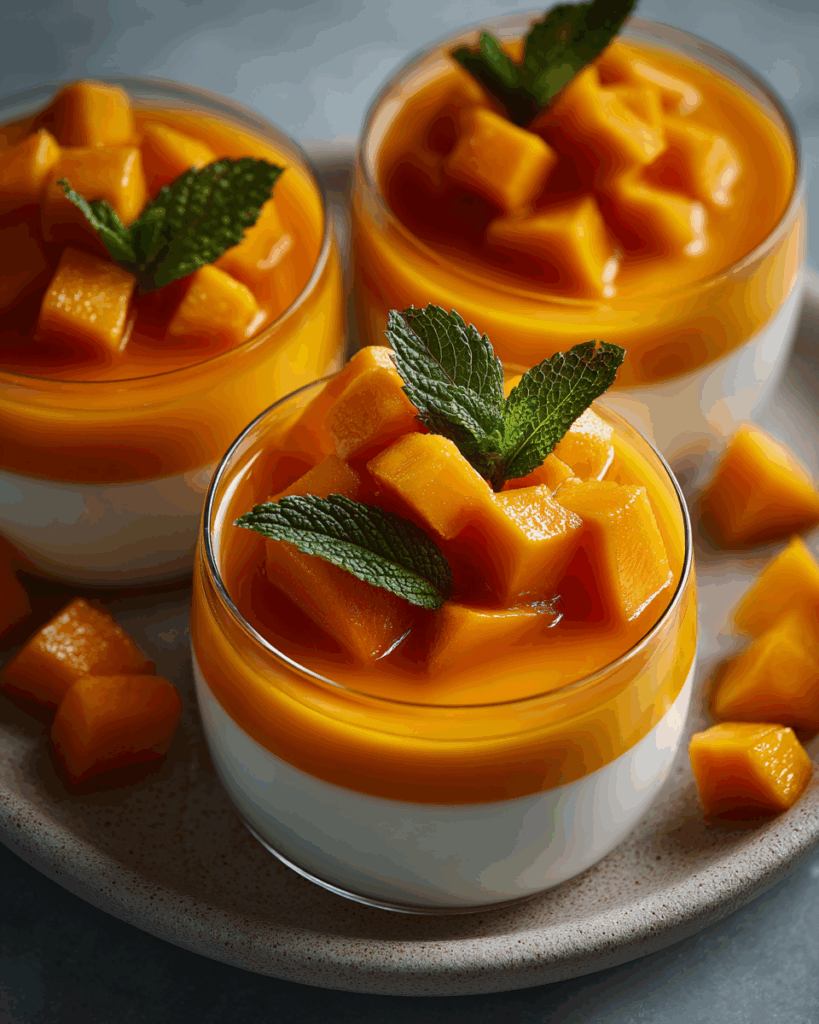
One of the reasons people fall in love with Coconut Panna Cotta with Mango Puree is how flexible it is. The base recipe is already dreamy, but you can customize it toward dairy free, more fruity, more tangy, more elegant for guests, or more fun for kids. I am going to walk you through several styles that answer what a lot of readers ask for when they search things like coconut panna cotta with mango puree bbc good food, mango coconut panna cotta recipe, mango panna cotta, mango panna cotta BBC food, and coconut panna cotta masterchef. You can think of this section as your creative menu.
Dairy free Coconut Panna Cotta with Mango Puree
If you like the idea of coconut panna cotta with mango puree no cream, this is the version you will want to try. Instead of using heavy cream, replace it with full fat coconut milk or canned coconut cream. This gives you a Coconut Panna Cotta with Mango Puree that is fully coconut forward, with no dairy. The mouthfeel will be slightly thicker and a touch denser, kind of like coconut custard, but still smooth. Because you lose the dairy fat from the cream, the coconut flavor becomes more noticeable, which is perfect if you really love coconut. Gelatin will still set it, so the texture should hold.
Layered mango jelly and panna cotta
For a mango panna cotta pudding recipe presentation, you can make a two layer dessert. Fill each glass halfway with the coconut base for Coconut Panna Cotta with Mango Puree, then chill it until it is softly set. Meanwhile, make a quick mango layer by blending mango puree with just a touch of sugar and blooming a very small amount of gelatin in warm mango puree.
Let it cool slightly, then pour on top of the coconut layer and chill again. Now you have Coconut Panna Cotta with Mango Puree, but in a stacked, clear color block style that looks like something from a nice hotel buffet. It is elegant and playful at the same time.
Mini party cups
If you are planning a party or hosting a holiday dinner, consider making Coconut Panna Cotta with Mango Puree in very small glasses or shot style dessert cups. You only pour a few spoonfuls of the panna cotta base in each, then top with a little mango puree once set. People love mini desserts because it lets them try a little of everything without committing to a giant portion. This style also travels well for potlucks because the Coconut Panna Cotta with Mango Puree is already portioned and covered.
Spiced mango topping
This is for people who like a little twist. Blend your mango puree with a tiny pinch of warm spice, like cardamom or ginger, before you spoon it over the chilled coconut base. This gives Coconut Panna Cotta with Mango Puree a more layered flavor profile. The spice does not make it taste like curry or anything savory, it just gives a gentle warmth in the background. The result can feel more grown up, which makes this take on Coconut Panna Cotta with Mango Puree great for dinner parties.
Coconut and lime
Another variation is to brighten the coconut layer. Add a very small amount of fresh lime zest to the coconut milk and cream when blooming and heating, then strain it out before chilling. The citrus gives Coconut Panna Cotta with Mango Puree a high note that cuts through the richness. When you spoon mango puree on top, you get sweet, creamy, and tangy in one bite. This variation reminds some people of tropical drinks by the beach.
Toasted coconut crunch
If you want to add texture to Coconut Panna Cotta with Mango Puree, toast a handful of unsweetened coconut flakes in a dry pan over low heat until lightly golden. Let them cool fully so they get crisp. Sprinkle them on top of each serving right before you serve it. Now each spoonful of Coconut Panna Cotta with Mango Puree gives creamy, juicy, and crunchy all together.
Berry and mango swirl
If you have guests who are not obsessed with mango, or you just want a different color contrast, you can blend raspberries or strawberries with a touch of sugar and swirl that into the mango puree. When you spoon this marbled fruit topping over the chilled coconut base, the Coconut Panna Cotta with Mango Puree becomes a little more dramatic looking. This version looks especially nice in clear glasses where you can see the yellow and red swirls.
Restaurant style plating
If you want that coconut panna cotta masterchef style presentation, you can go one step further and unmold. Lightly oil small ramekins before pouring in the coconut base. Once it has fully set in the fridge, dip the bottom of each ramekin in warm water for a few seconds, then flip it gently onto a plate.
Spoon the mango puree around the panna cotta instead of on top. Add fresh mango cubes, and maybe a mint leaf. Now you have Coconut Panna Cotta with Mango Puree on an actual plate instead of in a glass, just like a plated dessert in a dining room. This style is perfect for a more formal dinner.
These variations are proof that Coconut Panna Cotta with Mango Puree can be shaped for almost any occasion. Light and dairy free, playful and swirled, elegant and plated, or casual in a glass with a spoon. The base idea stays the same, which is coconut cream meets ripe mango, but you can let the details match your mood and audience.
Nutrition and Health Benefits
We are going to talk about nutrition and wellness in a real life way, not in a strict diet way. Coconut Panna Cotta with Mango Puree is a dessert, so it is naturally sweet and rich. But Coconut Panna Cotta with Mango Puree also brings real fruit, some satisfying fats that help you feel full, and a calm kind of sweetness that makes one serving feel special and complete. In this section, I will use the name Coconut Panna Cotta with Mango Puree many times on purpose, because I want to keep things clear and focused on this exact recipe, not a different panna cotta.
First, let us look at an estimated nutrition snapshot for Coconut Panna Cotta with Mango Puree, based on roughly four servings. Coconut Panna Cotta with Mango Puree usually comes in at around 300 to 350 calories per serving, depending on how much sugar you add to the base and how much mango puree you spoon on top. Coconut Panna Cotta with Mango Puree often has a decent amount of fat, mostly from coconut milk and heavy cream, and most of that fat is saturated fat.
Coconut Panna Cotta with Mango Puree will typically include about 22 grams of fat per serving, which is why it tastes so velvety and rich. Coconut Panna Cotta with Mango Puree also has some carbohydrates, usually around 26 to 30 grams, which come from both the added sugar and the natural sugar in the mango. Coconut Panna Cotta with Mango Puree is not high protein, but you still get a few grams of protein from the cream and the gelatin.
Now let us talk about each main ingredient in Coconut Panna Cotta with Mango Puree and how it supports the body in different ways. Coconut milk is a core part of Coconut Panna Cotta with Mango Puree. Coconut milk contains fats called medium chain triglycerides, also known as MCTs. Some studies suggest that MCTs may be metabolized a little differently compared to some other fats, and they can provide energy fairly quickly.
That means Coconut Panna Cotta with Mango Puree can feel satisfying in a smaller portion, because coconut fat gives that full, content feeling after just a few spoonfuls. I like that about Coconut Panna Cotta with Mango Puree. It is not the kind of dessert that makes you keep eating and eating without stopping. A small glass feels enough.
Next, let us look at mango. Mango is not just here to make Coconut Panna Cotta with Mango Puree pretty. Mango brings vitamin C, vitamin A in the form of beta carotene, and fiber. Vitamin C is known for supporting the immune system. Vitamin A supports vision and skin. Fiber can support digestion and help balance the sweetness.
So when you add that golden layer to Coconut Panna Cotta with Mango Puree, you are adding more than color. You are adding fruit based nutrition. That is one reason Coconut Panna Cotta with Mango Puree feels fresher and less heavy compared to some cream only desserts.
Now we should mention sugar. Coconut Panna Cotta with Mango Puree does contain sugar, both added and natural. This is not a sugar free dessert. But you are totally allowed to adjust that. If you prefer a Coconut Panna Cotta with Mango Puree that leans more fruity and less sweet, you can reduce the white sugar in the coconut base to one fourth cup instead of one third cup.
You can also rely more on natural sweetness from extra mango puree on top. The flavor of Coconut Panna Cotta with Mango Puree will still be beautiful. It will just taste a little more bright and fruity and a little less like a traditional custard style dessert.
Portion size and mindset are important too. Coconut Panna Cotta with Mango Puree is naturally rich. That means it is a slow dessert, not a fast dessert. You sit down with Coconut Panna Cotta with Mango Puree, you take a spoonful, and you let it melt.
When desserts are higher in fat, like Coconut Panna Cotta with Mango Puree, they usually encourage slower eating. Slower eating can help you feel satisfied sooner. So even though Coconut Panna Cotta with Mango Puree is indulgent, you might find that you are happy with a small glass instead of a big bowl. That is a nice balance.
Something else I like about Coconut Panna Cotta with Mango Puree is that it can be adapted for different needs. If you need a Coconut Panna Cotta with Mango Puree that is dairy free, you can use all coconut milk, which removes the heavy cream and makes the dessert easier on people who are sensitive to dairy.
If you are looking for a Coconut Panna Cotta with Mango Puree that feels lighter after a spicy meal, you can serve it in tiny tasting cups the way you would see in a tasting menu. If you want Coconut Panna Cotta with Mango Puree for a summer party, you can make small portions and keep them cold on a tray of ice. You get options without losing that tropical personality.
We should also talk about emotional comfort, which is a real part of food. Coconut Panna Cotta with Mango Puree is cool, soft, sweet, and gentle. Coconut Panna Cotta with Mango Puree feels soothing on a warm evening when you want something cold and calm after dinner. Coconut Panna Cotta with Mango Puree is also a nice make ahead dessert for guests who might not love very sugary baked desserts like frosted cake.
Coconut Panna Cotta with Mango Puree gives you something creamy and fruity instead of something heavy and bready. For that reason, Coconut Panna Cotta with Mango Puree works beautifully at the end of a Thai inspired or Southeast Asian inspired meal, especially meals that include chili, lemongrass, or curry, because Coconut Panna Cotta with Mango Puree cools the palate.
In other words, Coconut Panna Cotta with Mango Puree is not just pretty. Coconut Panna Cotta with Mango Puree is satisfying, it is flexible, it delivers fruit, and it can be made in portions that feel reasonable, calm and joyful. Coconut Panna Cotta with Mango Puree is the type of dessert you can actually serve proudly and enjoy without guilt or panic, because Coconut Panna Cotta with Mango Puree is about balance, not about extremes.
Make Ahead, Storage, and Freezing
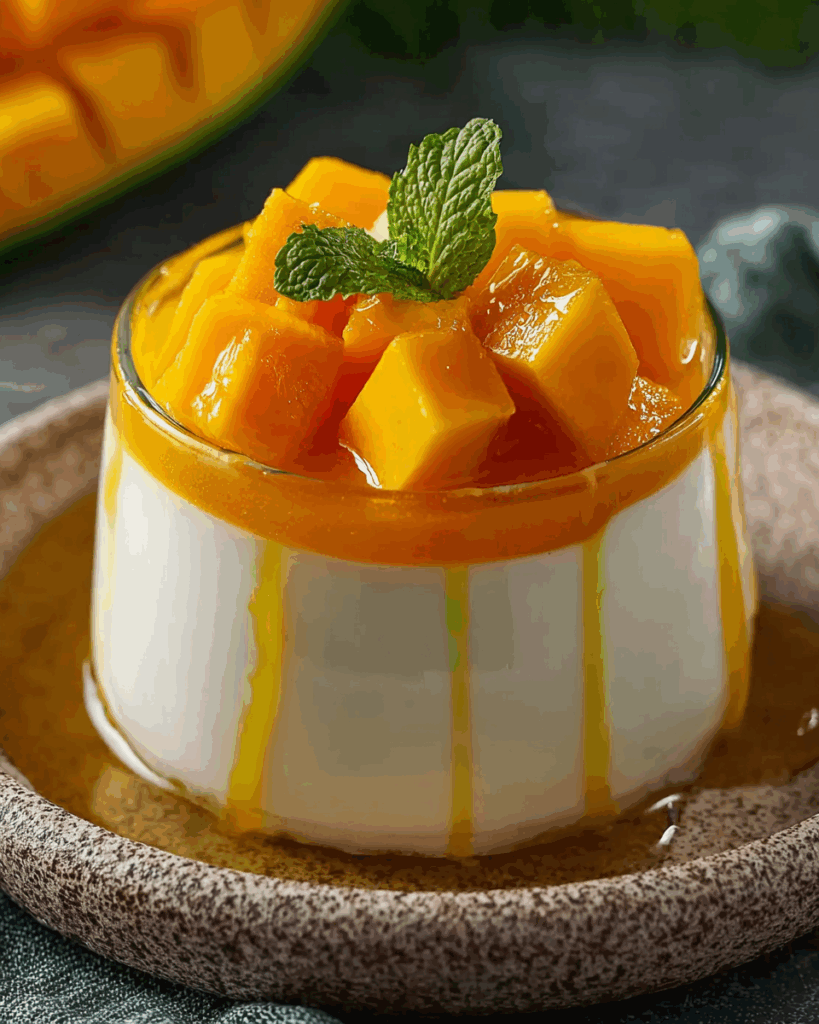
One of the best things about Coconut Panna Cotta with Mango Puree is that it is incredibly forgiving when it comes to timing. If you are someone who likes to plan meals ahead or you just do not want to be cooking dessert while your guests are already at the table, this recipe will make your life easier. Coconut Panna Cotta with Mango Puree is the perfect make ahead dessert because it needs time to chill anyway, and that means you can prepare it the night before and wake up already halfway done.
Let’s start with the make ahead process. When I make Coconut Panna Cotta with Mango Puree for a dinner party, I usually start the coconut base early in the morning or even the evening before. Once I pour it into cups and place them in the fridge, I forget about it. The panna cotta sets beautifully overnight, which frees me up to handle main courses or appetizers the next day. Then, about two hours before serving, I blend the mango puree and top the chilled cups. By the time dessert time comes around, the mango layer has set just enough to stay in place but is still silky and fresh.
The texture of Coconut Panna Cotta with Mango Puree actually improves slightly as it sits in the refrigerator for several hours. The gelatin relaxes, and the coconut flavor gets a little deeper. That is why professional kitchens love panna cotta. It is make ahead by nature, which helps a lot when you have multiple dishes to juggle.
Now, let us talk about storage. Once Coconut Panna Cotta with Mango Puree is made, it should always stay refrigerated. Cover each cup or glass with plastic wrap, or if you have reusable silicone lids, use those. This keeps the surface from drying out and prevents the dessert from picking up any fridge odors, which coconut milk tends to absorb easily. If you have ever opened your fridge and noticed that even sealed foods share a bit of the same smell, that is exactly what we are trying to avoid here. So cover it well.
You can store Coconut Panna Cotta with Mango Puree for up to three days in the fridge. After that, the texture might start to change. The coconut layer can weep a little liquid, and the mango puree may lose its bright color. Three days is your best window for perfect texture and flavor. If you need to make it earlier than that, you can make just the coconut layer and add the mango puree on the day you plan to serve.
Freezing Coconut Panna Cotta with Mango Puree is possible but not ideal. The issue with freezing panna cotta is that gelatin and dairy do not always freeze and thaw gracefully. When you thaw a frozen panna cotta, the texture can become grainy and slightly watery because the fat and liquid separate during freezing. If you must freeze it, freeze only the coconut base without the mango topping. Once thawed slowly in the refrigerator overnight, you can blend fresh mango puree and spoon it over right before serving.
If you really want to test how well Coconut Panna Cotta with Mango Puree freezes, try one small cup as an experiment before committing to a whole batch. Everyone’s freezer behaves differently, and sometimes, depending on humidity or how airtight your container is, results vary. Personally, I like Coconut Panna Cotta with Mango Puree best fresh from the fridge, not from the freezer.
A quick tip on transporting. If you plan to take Coconut Panna Cotta with Mango Puree to a friend’s house or picnic, make sure it stays cold. Place the cups in a cooler bag with ice packs around them. Coconut Panna Cotta with Mango Puree needs cold to maintain its soft, custardy texture. Even a short period in warm air can start to melt the gelatin hold.
If you store Coconut Panna Cotta with Mango Puree properly, you will find that it tastes even better after a few hours of rest. The top layer of mango becomes glossy, and the coconut base feels extra smooth. That is the beauty of this dessert. It actually rewards patience.
Common Mistakes to Avoid
Even though Coconut Panna Cotta with Mango Puree sounds fancy, it is honestly one of the easiest desserts you can make. Still, there are a few common mistakes people make that can affect the final texture or look. I have made most of these mistakes myself over the years, and once you know what to watch for, it becomes second nature to get it right every time.
The first big mistake is overheating the coconut milk and cream mixture. Coconut milk is delicate, and when it gets too hot, the fat can separate from the liquid, giving you a grainy texture instead of smooth. You never want the mixture to boil hard. Keep it at a gentle simmer or warm enough that the gelatin dissolves and the sugar melts. Think of it like gently coaxing everything together, not rushing.
The second mistake is skipping or rushing the blooming step for gelatin. Blooming gelatin in cold liquid before heating lets it soften and dissolve evenly. If you skip this, the gelatin can clump and you will end up with rubbery bits that never fully melt. Always sprinkle gelatin on top of cold liquid and let it sit untouched for about five minutes before turning on the heat.
Another mistake is using low quality coconut milk. For Coconut Panna Cotta with Mango Puree, you really need a thick, creamy coconut milk that has at least 17 to 20 percent fat. Light coconut milk or coconut beverage from a carton will give you a watery panna cotta that never feels quite right. Full fat coconut milk makes the difference between silky and soupy.
One subtle mistake is adding mango puree too early. If the coconut layer has not fully set, the mango will sink into it and mix instead of sitting as a separate golden layer. The result tastes fine but looks messy. Wait until the panna cotta feels firm when gently tapped before topping it.
Sometimes, people make Coconut Panna Cotta with Mango Puree and get frustrated because it doesn’t release from the ramekin easily when they want to unmold it. The trick is to lightly grease the ramekin with neutral oil before pouring in the mixture. When it is time to unmold, dip the ramekin bottom in warm water for a few seconds, then slide a knife gently around the edge. It should slide right out.
A few people also accidentally over-set their panna cotta by using too much gelatin. Two teaspoons is really enough for this recipe. More gelatin makes Coconut Panna Cotta with Mango Puree rubbery instead of soft and wobbly. You want it to barely hold shape when you scoop it.
One last small but real mistake is not tasting the mango before pureeing. Mango flavor can vary from super sweet to almost sour depending on ripeness and variety. If your mango is very tart, you might need to add a teaspoon of sugar or a drizzle of honey before blending. Otherwise, the topping might taste too tangy next to the creamy coconut.
Every one of these mistakes is fixable. And that is what I love about Coconut Panna Cotta with Mango Puree. Even if you make a small error, it usually still turns out delicious. It might not look perfect the first time, but it will always taste good.
Cultural and Historical Background
Coconut Panna Cotta with Mango Puree might sound like an Italian dessert because panna cotta itself comes from Italy, but this version has a deeply Asian soul. Traditional panna cotta means “cooked cream” in Italian. It was originally made with milk, cream, and sugar thickened with gelatin, then chilled. It became a simple yet elegant dessert across Northern Italy, often served with berries or caramel sauce.
When coconut milk entered the mix, panna cotta took on a tropical twist. Coconut Panna Cotta with Mango Puree is a kind of cultural fusion that happened naturally as ingredients traveled and chefs experimented. Coconut milk is a staple in Southeast Asian kitchens, especially in Thailand, Malaysia, Indonesia, and the Philippines. It adds richness and aroma to both savory dishes and desserts.
The Thai influence in Coconut Panna Cotta with Mango Puree is especially noticeable through the use of pandan leaves and mango. In Thai cooking, coconut milk and pandan often appear together in traditional sweets like pandan coconut jelly, coconut sticky rice, or custard filled desserts wrapped in banana leaves.
Mango, too, is deeply tied to Thai dessert culture. The most famous example is khao niaow mamuang, or mango sticky rice, where warm sticky rice is topped with coconut sauce and ripe mango slices. Coconut Cotta with Mango Puree feels like a modern echo of that dish, using European technique but Southeast Asian flavors.
It is easy to imagine how this hybrid dessert developed. Travelers, chefs, and home cooks began to mix ideas. Someone familiar with panna cotta realized that coconut milk could stand in for cream, and mango could replace berries as a topping. From there, Coconut Panna Cotta with Mango Puree became a favorite across restaurants that specialize in Asian fusion or tropical themes.
There is also something symbolic about this combination. In many tropical countries, coconut trees and mango trees are seen as gifts from nature, symbols of abundance and hospitality. Serving Coconut Panna Cotta with Mango Puree at a gathering feels like offering a taste of the tropics, even if you live somewhere cold.
When you take that first spoonful of Coconut Cotta with Mango Puree, you are tasting a bridge between continents. The Italian idea of smooth, creamy, chilled custard meets the Thai and Southeast Asian love of coconut and fruit. It is a small reminder of how food keeps evolving, how cultures connect through flavor, and how creativity in the kitchen makes the world feel a little smaller.
Coconut Cotta with Mango Puree is a story in a cup. It is history meeting comfort. It is tradition blending with imagination. And that, honestly, is why this dessert never goes out of style.
Serving Suggestions
Serving Coconut Cotta with Mango Puree is honestly one of the most fun parts of the whole process, because you get to decide how fancy or how relaxed you want it to feel. Coconut Panna Cotta with Mango Puree can be plated for a date night, or it can be scooped casually out of small cups after family dinner.
Coconut Cotta with Mango Puree works for birthdays, brunch, and holiday menus. Coconut Cotta with Mango Puree even works for warm weather cookouts where everybody wants something cold and creamy at the end of the meal. The dessert is versatile in a way that not every dessert is, and that makes Coconut Panna Cotta with Mango Puree a go to choice when you want something tropical without a lot of stress.
One of my favorite ways to serve Coconut Cotta with Mango Puree is in small clear glasses. When Coconut Panna Cotta with Mango Puree is layered in glass, you see the pale coconut base sitting under that bright golden mango layer. It is beautiful even with no garnish. You can chill Coconut Panna Cotta with Mango Puree right in the glass you are going to serve, which means you do not have to unmold or flip anything. This style is great for a casual dinner at home where you pass out spoons and say, dessert is ready.
If you want Coconut Panna Cotta with Mango Puree to feel a little more restaurant style, you can unmold it onto a plate. To do this, lightly oil small ramekins before you pour in the panna cotta base and chill it. When it is set, dip the bottom of the ramekin in warm water for a few seconds, run a thin knife around the edge, and gently flip it out. You will end up with a smooth dome of Coconut Panna Cotta with Mango Puree.
Then spoon the mango puree around the panna cotta instead of only on top. Add a few tiny cubes of fresh mango and maybe a mint leaf. Now Coconut Cotta with Mango Puree is not just dessert in a cup. Coconut Panna Cotta with Mango Puree becomes a plated dessert that looks ready for a dining room menu.
You can also serve Coconut Cotta with Mango Puree in tasting size portions for a party or buffet. Think little shooter glasses, tiny jars, or small espresso cups. A party tray filled with six or eight mini servings of Coconut Cotta with Mango Puree is always a hit because people feel comfortable taking a small taste. Sometimes guests want something sweet but do not want to commit to cake or pie. Giving them a cool, smooth little Coconut Panna Cotta with Mango Puree lets them finish the meal refreshed instead of heavy.
Let’s talk about toppings. Coconut Cotta with Mango Puree is already balanced, so you do not have to add anything to it at all. But if you want texture, try a sprinkle of toasted coconut flakes on top right before serving. Toasted coconut brings out even more tropical flavor in Coconut Panna Cotta with Mango Puree and it adds a tiny crunch to the silky spoonful.
Another beautiful topping for Coconut Cotta with Mango Puree is finely diced fresh mango. The puree is smooth, and the diced mango gives a juicy pop in every bite. You could also add a very light drizzle of coconut milk or coconut cream over the top of the mango layer, just a whisper of white against the gold. When people see Coconut Panna Cotta with Mango Puree served like that, it looks hand crafted and thoughtful.
Now, what do you serve with Coconut Cotta with Mango Puree on the plate or on the table? After a spicy meal, Coconut Panna Cotta with Mango Puree is perfect because it cools the mouth. If you made something with chili, lemongrass, curry paste, or fried garlic, Coconut Panna Cotta with Mango Puree will calm things down and refresh the palate.
After grilled seafood, Coconut Panna Cotta with Mango Puree feels elegant. After roasted chicken or a coconut milk based soup, Coconut Panna Cotta with Mango Puree carries the coconut theme all the way to dessert, which makes the whole meal feel intentional.
Another small detail. Temperature matters. Coconut Cotta with Mango Puree should always be served chilled. The coconut layer should be softly set and cool. The mango puree should be cold and silky.
Do not let Coconut Panna Cotta with Mango Puree sit on the table for an hour while you talk and forget about it. If you are not serving it yet, keep Coconut Cotta with Mango Puree in the fridge until the exact moment you are ready to bring it out. That first cold spoonful of Coconut Panna Cotta with Mango Puree is honestly part of the experience.
Last idea. Breakfast dessert. I am not saying eat Coconut Cotta with Mango Puree for breakfast every day, but the truth is, Coconut Panna Cotta with Mango Puree is really good as a morning treat with coffee. The coconut base tastes almost like a light coconut yogurt, and the mango topping tastes like a fresh fruit sauce. On a slow weekend, Coconut Panna Cotta with Mango Puree can feel like a little luxury to start the day.
The bottom line is this. Coconut Panna Cotta with Mango Puree can sit in a champagne glass and look fancy, or Coconut Cotta with Mango Puree can live in a mason jar and feel cozy. Coconut Panna Cotta with Mango Puree belongs at dinner parties, and Coconut Panna Cotta with Mango Puree also belongs in quiet moments at home. Coconut Panna Cotta with Mango Puree is flexible, generous, and honestly just joyful.
Conclusion
Coconut Cotta with Mango Puree is one of those recipes that makes you feel like you did something special for yourself and for the people you feed. Coconut Panna Cotta with Mango Puree is creamy, smooth, fruity, and cold.
Coconut Panna Cotta with Mango Puree is simple to prepare, but it never looks simple in the bowl or the glass. Coconut Panna Cotta with Mango Puree feels like something you would order at a restaurant, even though Coconut Panna Cotta with Mango Puree is mostly simmer, chill, blend, and spoon.
I love Coconut Panna Cotta with Mango Puree because it delivers contrast in every scoop. The coconut layer in Coconut Panna Cotta with Mango Puree tastes mellow and delicate, like a soft coconut custard. The mango layer in Coconut Panna Cotta with Mango Puree tastes bright and sunny, like tropical fruit at its sweetest point in summer.
When you eat Coconut Panna Cotta with Mango Puree, you taste both comfort and freshness at the same time. That is rare in desserts. A lot of desserts are either very heavy or very sharp. Coconut Panna Cotta with Mango Puree balances both sides so naturally.
FAQ
Can I use frozen mango for Coconut Panna Cotta with Mango Puree?
Yes, you can use frozen mango for Coconut Panna Cotta with Mango Puree, and honestly, it works better than you might expect.
How long can Coconut Panna Cotta with Mango Puree stay fresh in the refrigerator?
Coconut Cotta with Mango Puree can stay fresh for about three days in the refrigerator if it is covered well. After three days, the texture starts to change.
Can I make Coconut Panna Cotta with Mango Puree without gelatin?
Yes, you can make Coconut Cotta with Mango Puree without gelatin if you prefer a vegetarian or vegan version. The most common substitute is agar agar powder, which is derived from seaweed and works as a plant based setting agent. The process is a little different though.
Why did my Coconut Cotta with Mango Puree not set properly?
If your Coconut Cotta with Mango Puree did not set, it usually comes down to one of two things. Either the gelatin was not bloomed properly, or the mixture was overheated. Gelatin needs time to soften in cold liquid before it can activate. Sprinkle it evenly over the coconut milk and cream, let it sit for five full minutes without stirring, and then gently warm it. If you pour gelatin straight into hot liquid, it will clump, and those clumps never dissolve.
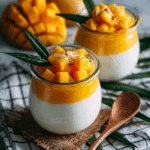
Coconut Panna Cotta with Mango Puree
- Prep Time: 10 minutes
- Cook Time: 10 minutes
- Total Time: 2 hours 20 minutes
- Yield: 4 servings 1x
- Category: Dessert
- Method: Chilled / No-Bake
- Cuisine: Thai Fusion
- Diet: Halal
Description
Coconut Panna Cotta with Mango Puree is a creamy, tropical Thai-inspired dessert made from coconut milk and heavy cream, topped with smooth mango puree for a refreshing and elegant treat.
Ingredients
- 1 cup coconut milk (full-fat)
- 1 cup heavy cream
- 2 teaspoons gelatin powder
- 1/3 cup sugar
- 2 pandan leaves, knotted (optional)
- 2 ripe mangoes
Instructions
- In a small saucepan, mix coconut milk and heavy cream together. Sprinkle the gelatin over the surface of the mixture and let it bloom for 5 minutes.
- Add sugar and knotted pandan leaves. Turn the heat to medium-low and stir constantly until the sugar and gelatin dissolve completely. Do not boil.
- Remove from heat and discard pandan leaves. Pour the mixture into small cups or ramekins. Refrigerate for 30 minutes to 2 hours until set.
- Peel and cut the mangoes into large chunks. Blend until smooth to make the puree. Optionally, reserve small cubes of mango for garnish.
- Top the chilled panna cotta with mango puree and fresh mango cubes before serving.
Notes
- Use full-fat coconut milk for a rich and creamy texture.
- Do not let the mixture boil; it can ruin the smooth consistency.
- Allow enough chill time for the panna cotta to set properly before adding the mango layer.
- You can substitute heavy cream with coconut cream for a dairy-free version.
- For extra aroma, use pandan leaves when heating the coconut milk mixture.
Nutrition
- Serving Size: 1 cup
- Calories: 320
- Sugar: 27g
- Sodium: 45mg
- Fat: 22g
- Saturated Fat: 18g
- Unsaturated Fat: 3g
- Trans Fat: 0g
- Carbohydrates: 28g
- Fiber: 2g
- Protein: 4g
- Cholesterol: 40mg
Keywords: Coconut Panna Cotta with Mango Puree, easy coconut panna cotta with mango puree, coconut panna cotta with mango puree no cream, mango coconut panna cotta recipe, mango panna cotta pudding recipe, coconut panna cotta masterchef

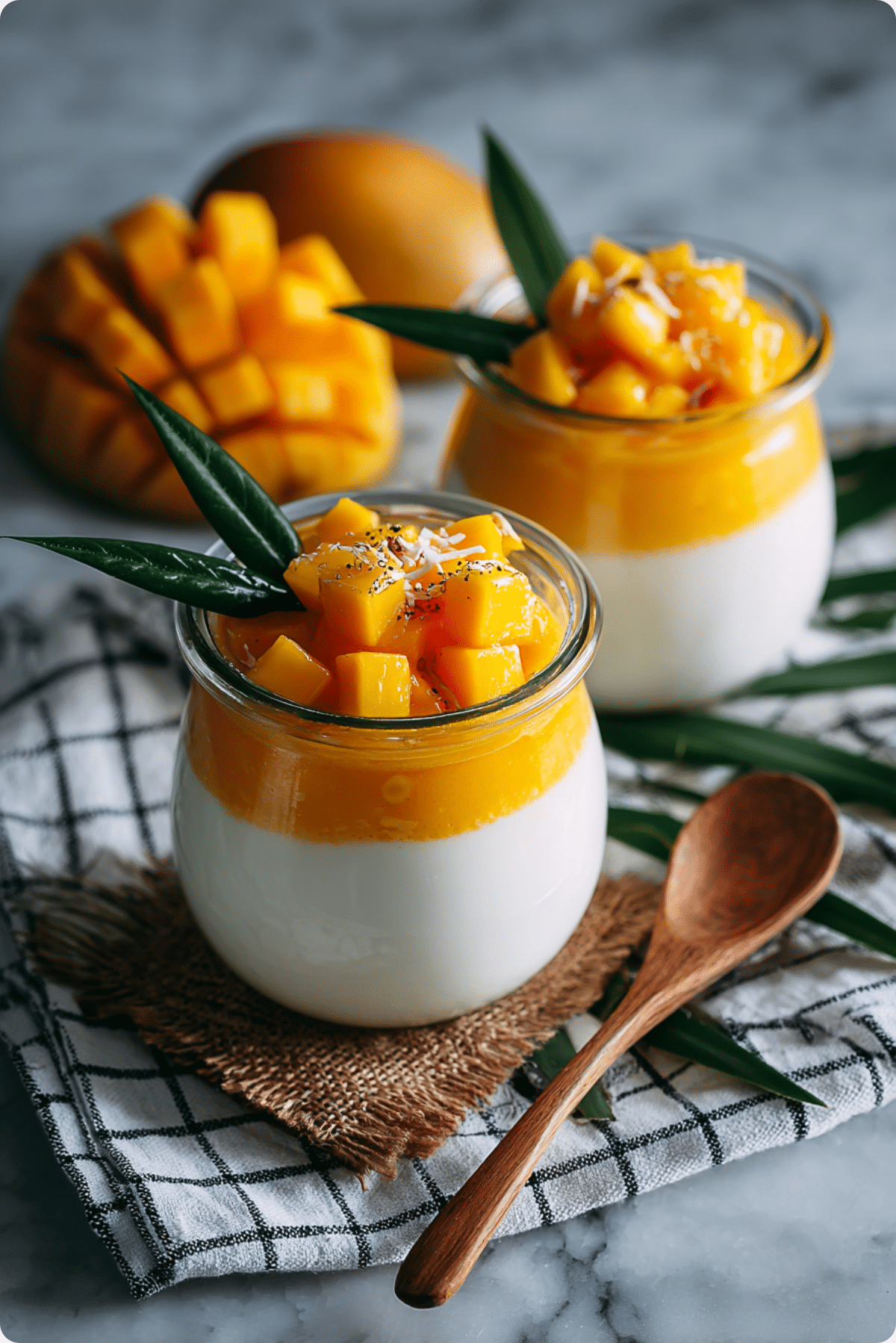
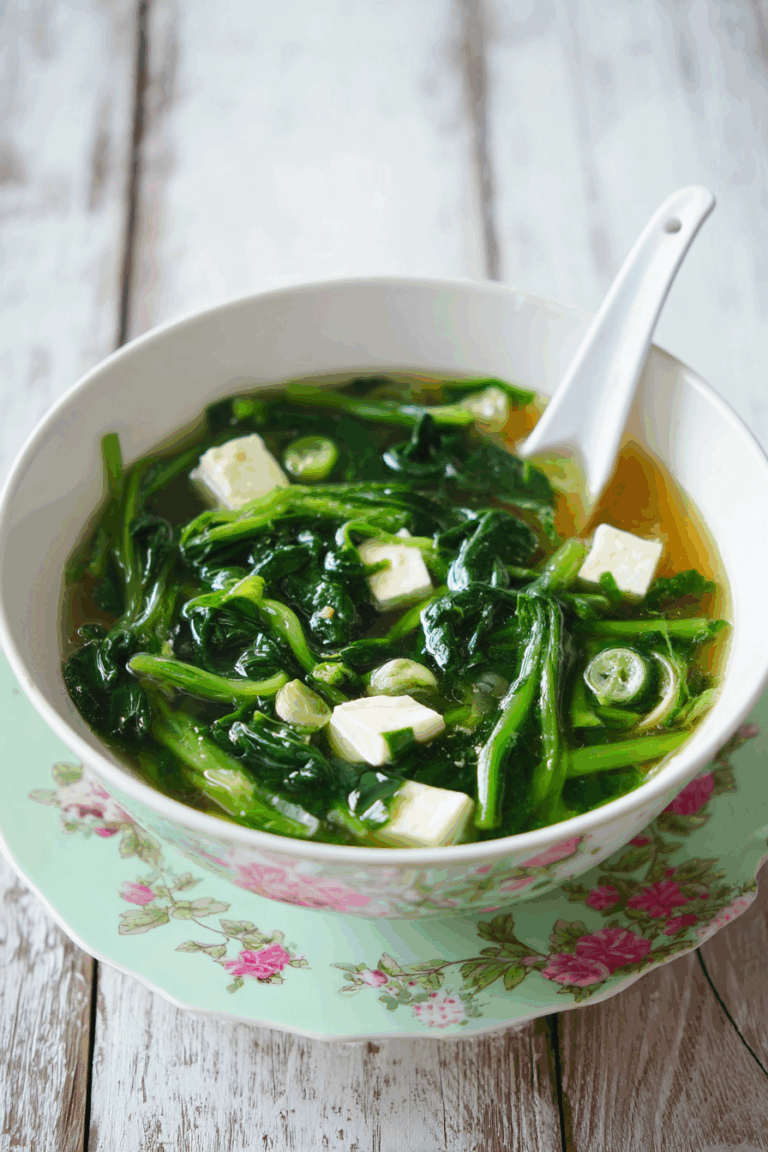
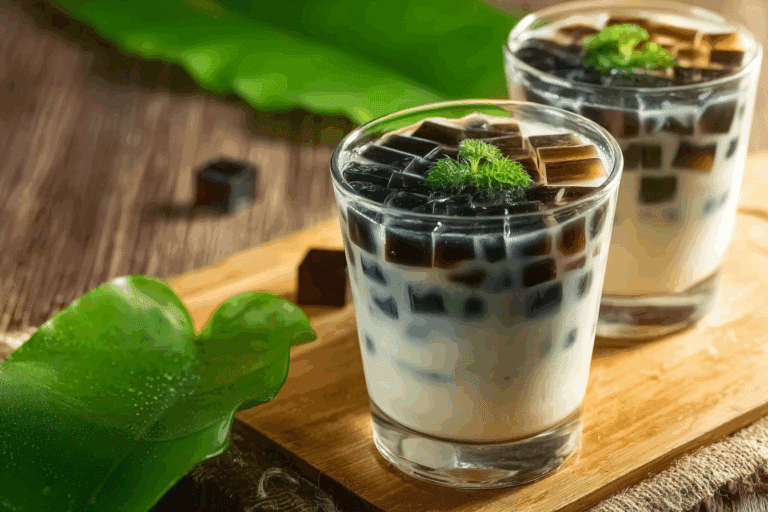
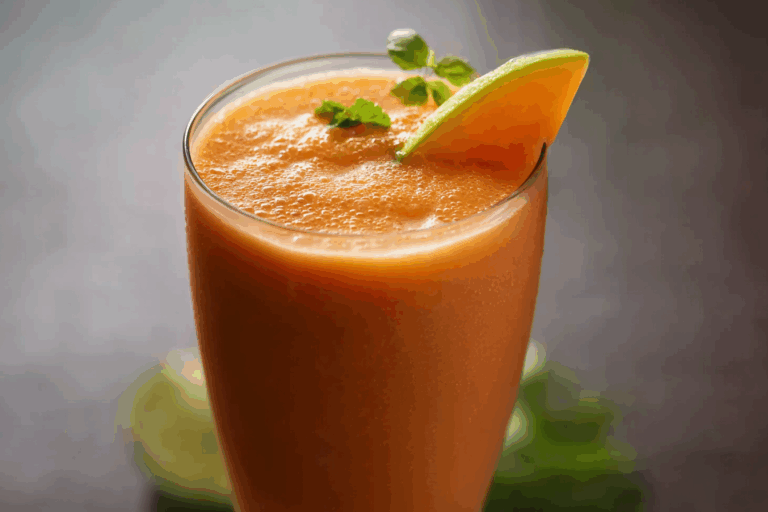
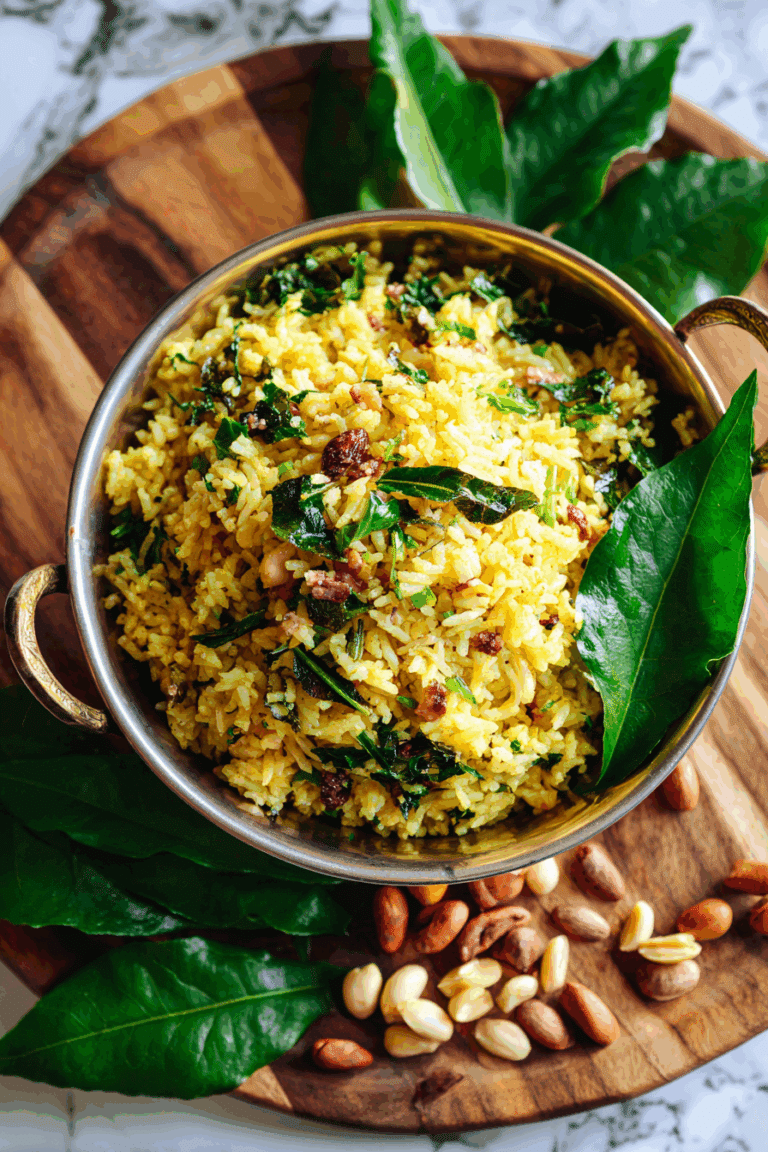
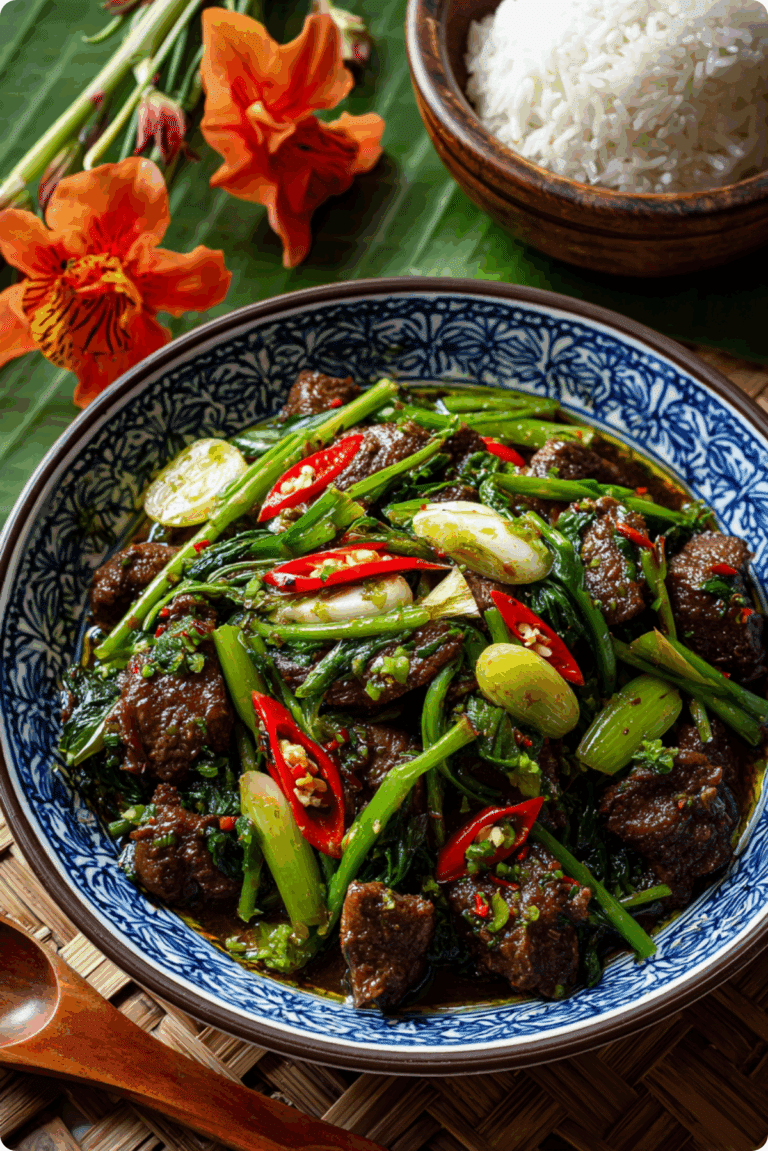
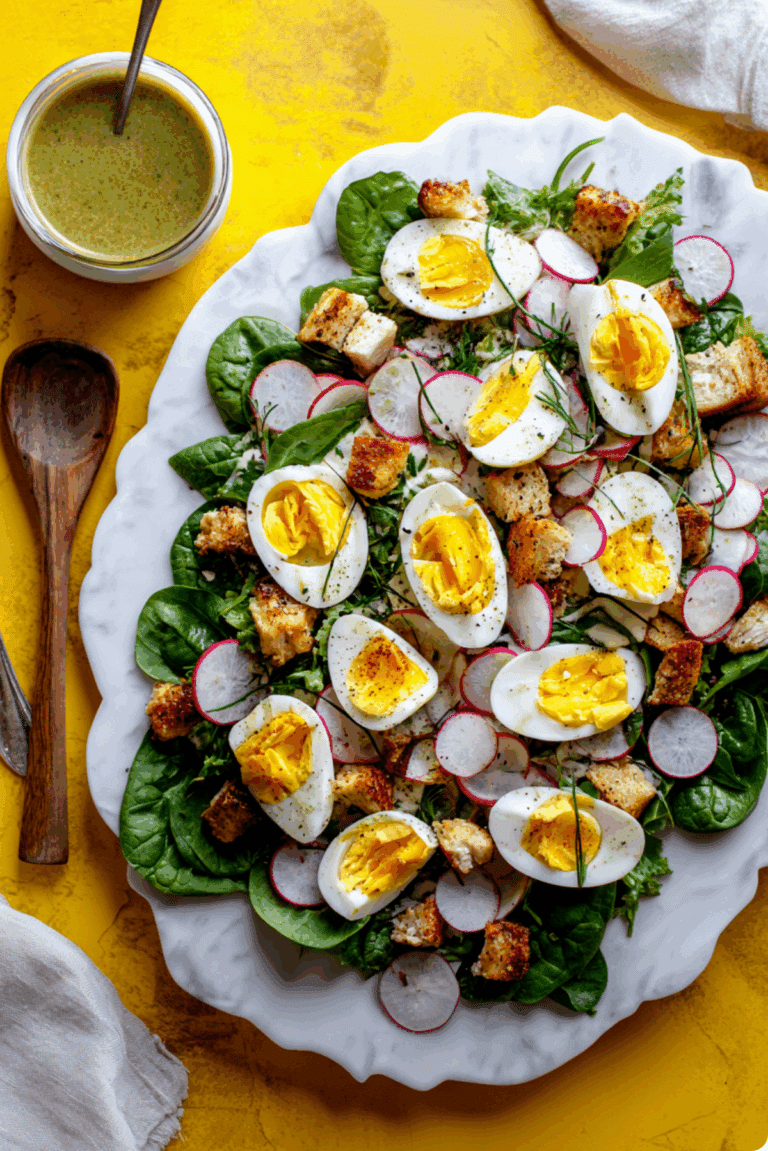
Good write-up, I?¦m regular visitor of one?¦s blog, maintain up the nice operate, and It’s going to be a regular visitor for a lengthy time.